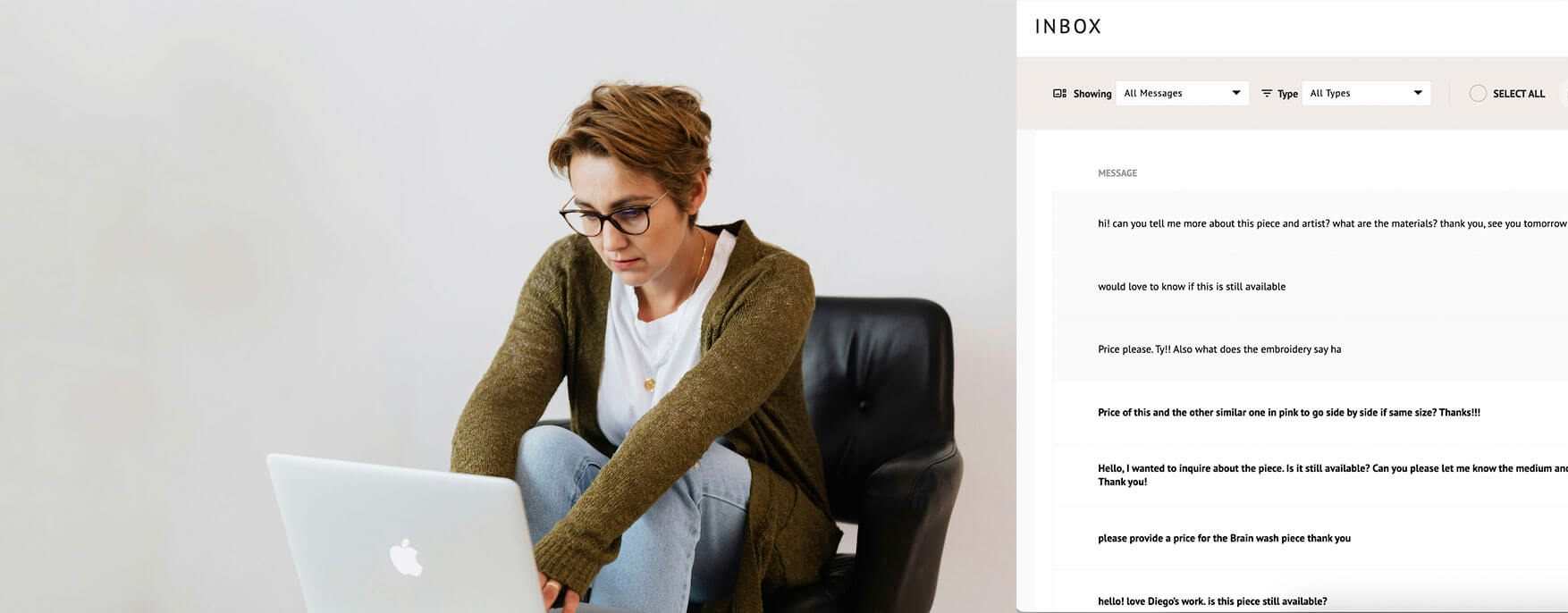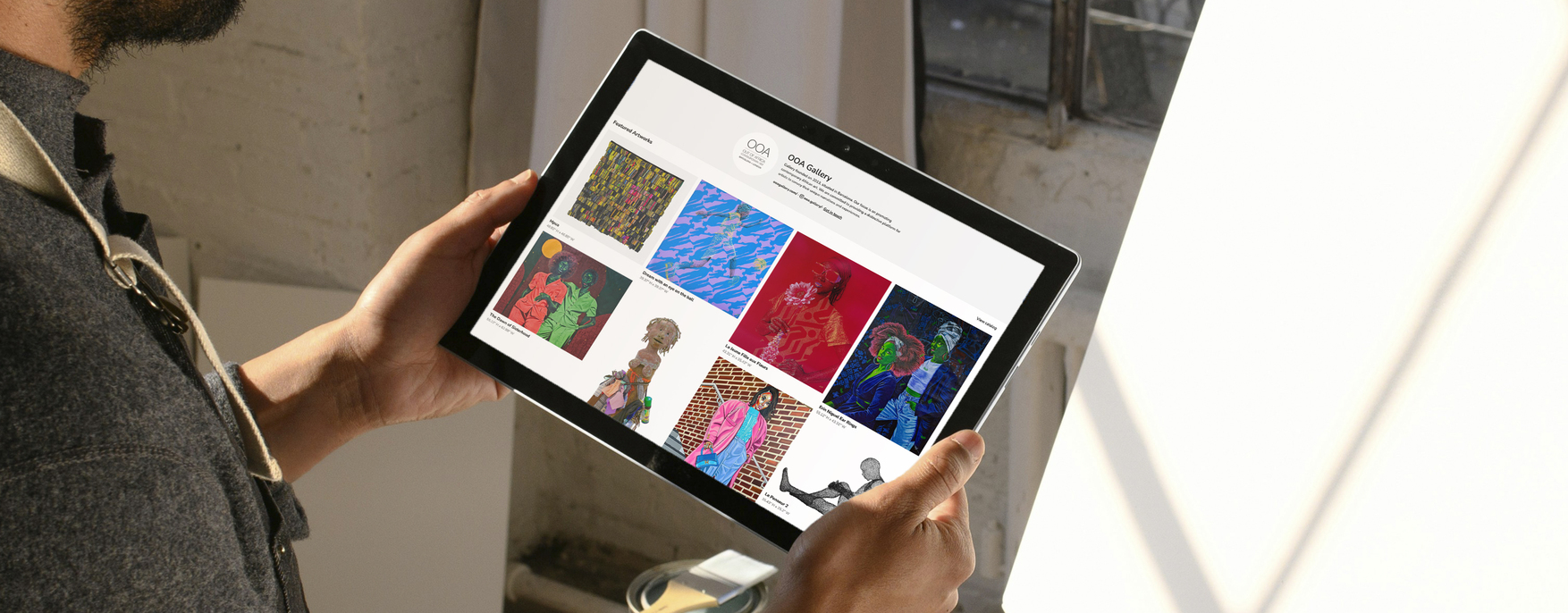If you really want to plan a strategy for the long-term success of your art business, one key point you need to cover is lead generation, also known as the art of collecting the information of potential collectors who have shown interest in your work, to nurture that conversation until they convert into actual art buyers.
This is an introductory guide for artists, gallerists, photographers, and art print sellers, on how to generate and nurture leads with the help of ArtPlacer’s art marketing tools.
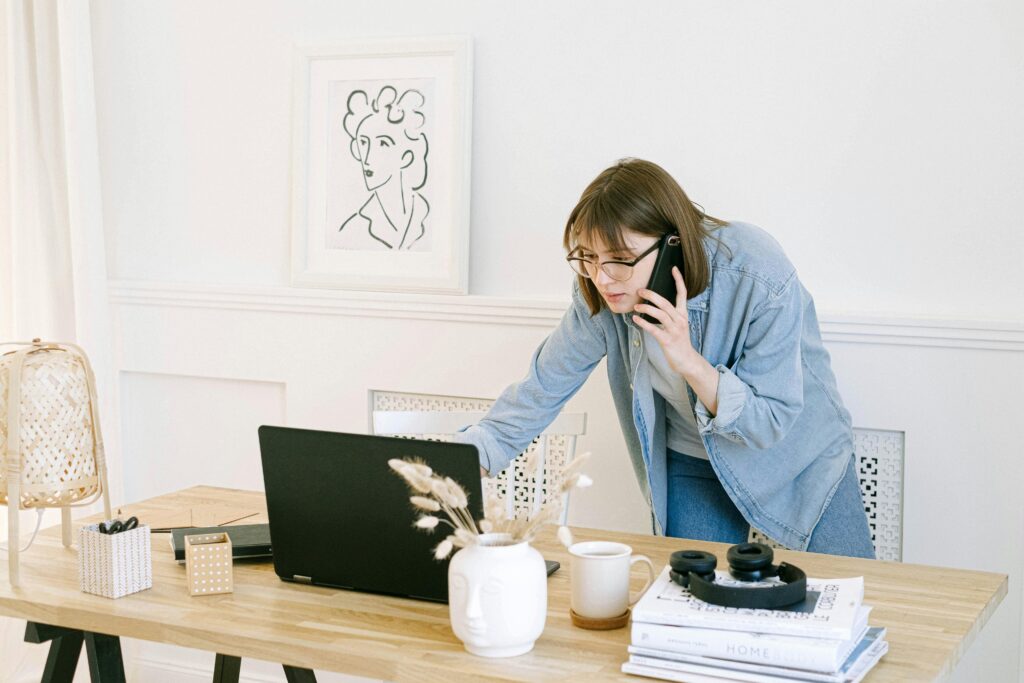
Generating leads is a way to keep your business growing while building long lasting customer relationships.
Contents
What is a lead?: Art marketing terms to know
In its simplest definition, a lead is a person who is a potential art buyer. A lead is someone who has expressed, via words or action, that they are interested in your work and would like to acquire it in the foreseeable future. In their life cycle leads can transition from visitors to your portfolio or website to actual customers or art collectors.
Who are your leads?:
-Visitors to your website
-Subscribers to your newsletter or mailing list
-Customers who have abandoned a shopping cart on your website
-Visitors to your online viewing room
-Social media followers
-Attendees to in situ or online art shows
-People who have made inquiries about an original work
Customers interested in a commissioned piece of artwork
Nurturing your leads will help you establish a relationship that leads to sales and overall growth for your art business.
What is lead generation?
When it comes to art marketing and sales, lead generation is the process of engaging with potential art buyers or collectors and guiding them through a journey that will end with a desired purchase.
Lead generation refers specifically to the action of establishing a line of communication with a potential customer who will provide their contact information to follow up with the next action that will move them further down their “art buyer’s journey”.
Yes, these interactions can happen live, for example, at an art fair or gallery, but in the digital era there are several instances where you can generate new leads to propel your art business, for example:
-Your Viewing Room
–Virtual Exhibitions or online 3D art shows
-Your online portfolio
-Your website
-Your social media channels
These instances should be touchpoints where potential customers can share their information.
Behind every new lead that joins your contact list there is a strategy and, furthermore, a tool that helps you collect and organize their information to nurture the relationship. The goal is to build a relationship through different art marketing pushes until the lead converts into a client or art collector.

With ArtPlacer’s Inbox section with prospect messages.
How to generate leads with ArtPlacer
ArtPlacer now has an integrated lead-generating tool that will help you collect information from potential art collectors easily and in an organized way.
There ArtPlacer offers four kinds of forms to collect lead information:
–Contact form: it collects the full name, email, and message from the visitor.
–Subscriber form: it captures the user’s full name and email address. This is an independent link you can add to your social media profiles, website, and even in QR form on your art fair boot or gallery.
–Inquire form: this form is on the artwork page and collects essential information like the visitor’s full name, email, and a brief message.
–Purchase form: getting the sender’s full name, email, and shipping address to acquire a piece.

Example of “Subscriber form” from ArtPlacer’s Online Portfolio.
Beyond capturing contact details, ArtPlacer now also offers a centralized way to review and manage all your collected leads. The “Contacts” section in your profile acts as your CRM dashboard showing names, emails, messages, and the origin of each interaction (such as Viewing Rooms, Online Portfolio, Mobile App, or Virtual Exhibitions). This lets you filter and prioritize leads based on their level of engagement and the platform they came from.
When a new inquiry comes in, it appears in your Inbox, where you can track conversations, reply directly, and stay organized. If the inquiry is about a specific artwork, that detail is automatically saved by your CRM, giving you a clear overview of the lead’s interest and journey.
But where and how does the lead generation happen? Here is how it has been seamlessly integrated to ArtPlacer’s art marketing tools.
Viewing Rooms as lead generators
Viewing Rooms are a powerful touchpoint to generate new leads. When a visitor explores a curated selection of artworks through this feature, they can inquire about specific pieces directly from the artwork page, using the “Inquire” form. Each inquiry automatically captures the visitor’s contact information and message, which is then stored in your Inbox and Contacts section, allowing you to follow up efficiently. This makes Viewing Rooms not just a space for beautiful artwork showcases but a tool to spark interest and initiate personalized conversations with potential collectors.
Subscriber form as a lead generator
The Subscriber form is ideal for capturing leads in physical spaces like art fairs or gallery exhibitions. You can generate a unique link to this form and turn it into a QR code, which can be printed and pasted on your art fair wall or gallery wall. Visitors can simply scan the code with their phones and leave their name and email address on the spot. This creates a seamless way to collect contact information from people who are already showing interest in your work—without needing to open a conversation immediately. Once the form is submitted, their details are added to your Contacts list, giving you the opportunity to follow up later with personalized updates or exclusive invitations.
Virtual Exhibitions as lead generators
With this new feature, you can turn your next 3D online art show into a lead generator if you want it. You can create “private” exhibitions that are accessible only once the visitor enters their full name, email, and a short message. To create an “early access” to your online art show, edit your Virtual Exhibition, go to the “Details” section, and, on the bottom menu, click on “Request visitor’s information to access.” Once you have collected potential buyers data you can make the exhibition public to all.
Once inside the virtual gallery, visitors also have access on the top right menu to the “Get in touch” button, a sort of virtual “guest book” where visitors can leave their information if they are interested in engaging further with your art business.
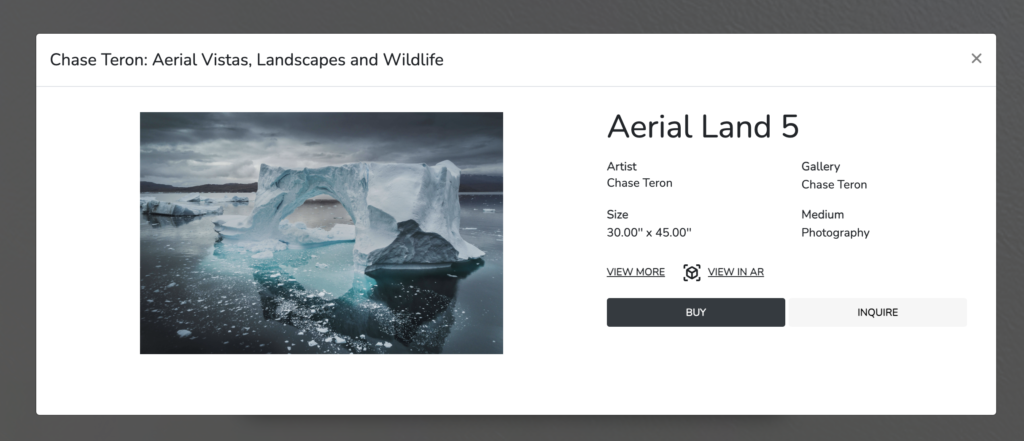
Once a visitor clicks on an artwork or the “Learn more” button to get further details, they can access the “Inquire” form.
Mobile app and Custom mobile app
From the ArtPlacer AR Mobile App or your bespoke Mobile App, users have two touch points where they can leave their information to connect with you. From your Profile page, they can access the “Contact” button, and then directly from the artwork page, they can make a direct inquiry, opening the door to a new conversation about acquiring the piece.
Online portfolio as a lead generator
From your Online Portfolio, visitors have several points of contact to leave their information, the “Get in touch” button at the top of the portfolio page and the “Contact form” at the bottom banner. Both touchpoints help you obtain contacts of visitors that you can nurture via email by sharing news about your gallery, upcoming shows, artist development, and more.
Plus, once they get to the page of an artwork they like, they can move further down their art buyer’s journey by making an Inquiry (Inquire form) or Purchase (Purchase form). Both actions trigger a notification in your ArtPlacer Inbox, so you can respond promptly. These interactions are also stored in your “Contacts” dashboard, helping you keep track of interest over time.
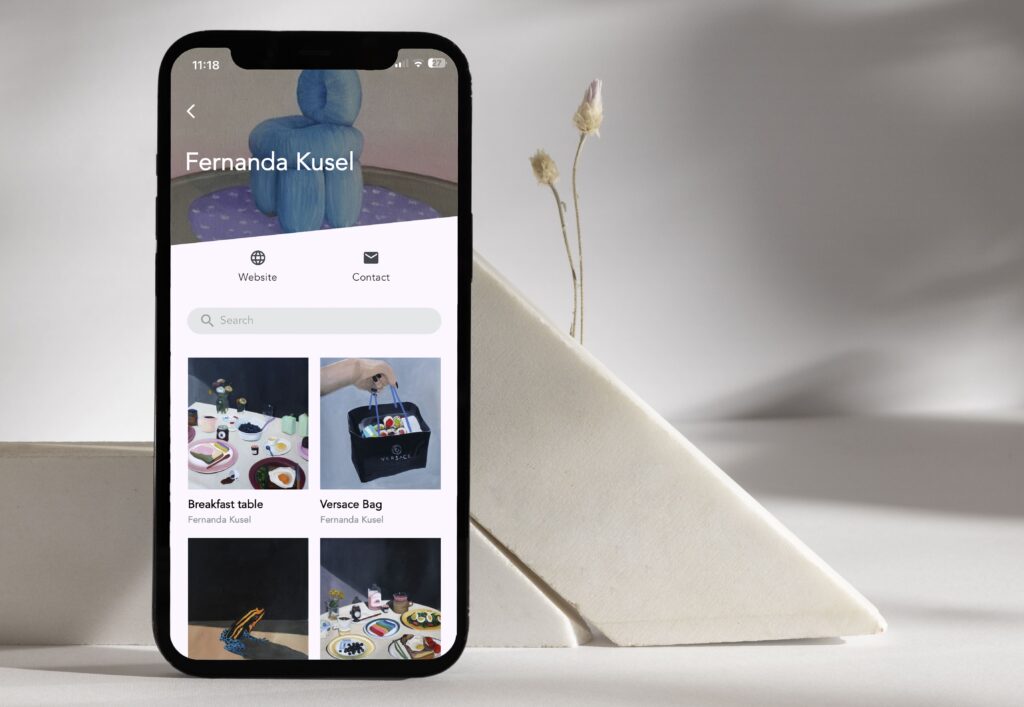
Nurturing your leads is the way to build a solid stream of sales coming from your online art business.
What is a lead magnet and how can it grow your art business
In the world of art marketing, a lead magnet is a free valuable asset you can offer to your target audience in exchange for their contact information. From discounts to exclusive or early bird access to an exhibition, the lead magnet entices the visitor to your website to share their name and email address.
Having a lead magnet on your website raises the stakes by generating leads that have already passed the “awareness” stage of their art buyer’s journey. This quality leads can be guided and nurtured with a personalized communication that can close the deal on an art sale or commission.
Lead magnets can help grow your art business by attracting potential customers and building a strong pipeline for them to follow. With ArtPlacer’s lead-generating tools, you can target an audience that is already interested in art and the possibilities of acquiring pieces for their collection at different price points.
Having one or more active lead magnets targeted to different audiences is not only a matter of growing your mailing list, this is a way to also reactivate past connections and bring back people who can be repeated customers.
Creating lead magnets with ArtPlacer Art Marketing tools
Currently, ArtPlacer offers one way to turn your current online art show into a lead magnet that can bring in the data of people interested in the showcased pieces and artists.
Under the “Virtual Exhibition” tag on ArtPlacer, you will find the option “Request visitor’s information to access,” as mentioned before. Once you activate this feature, you can share your online art show via a link through email and social media channels, as well as host it on your website, but in order to enter, visitors will be required to enter their name and email.
This way, you get a full list of potential clients you can reach out to with a follow-up message with further information about the collection and available pieces. Creating an easy-to-follow funnel from engagement to potential purchase.

Digital mockup created with Personal Spaces showcasing abstract art in a collector’s room.
Best practices for promoting your Lead generators points to collectors
Once you have a new lead, there are several ways that you can nurture that relationship. Here are some ideas you can integrate to use to build or enrich your existing art marketing strategy:
–ArtPlacer’s Personal Spaces mockups are a fantastic way to engage leads visually. You can send tailored room previews featuring an artwork your lead liked. This adds a personal touch and helps the collector envision how the piece could live in their own space.
-Write a personalized “welcome” email to leads coming from the ArtPlacer Subscriber form.
-Send a detailed follow-up email to all leads who have contacted you through the “Inquire form” and “Purchase form.”
-Share your artistic journey on a timely newsletter with lifestyle pictures of recent artworks made with Room Mockups.
-Provide regular updates about upcoming shows or exhibitions
-Send new leads from social media a direct link to your Online Portfolio
-Turn visitors into subscribers by adding a QR code to your gallery or art fair wall link to your “Subscriber form” lead magnet.
-Engage new leads by offering an exclusive discount via email.
Remember, nurturing a lead takes time and is a matter of building a long-term relationship that will lead to a sale and even repeat customers.
